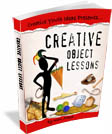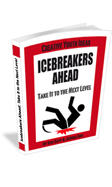“If a child is to keep alive his inborn sense of wonder, he needs the companionship of at least one adult who can share it, rediscovering with him the joy, excitement and mystery of the world we live in.”
Rachel Carson, The Sense of Wonder
Getting Back in Touch with Your Personal Creativity!
I am often asked, “How can you come up with so many Creative Ideas?”
Personally, I think all of us are born creative. We are born with a “Sense of Wonder”. Unfortunately, as we get older we tend to lose our sense of wonder. We figure everything out. Things began to have but one interpretation, the correct answer, a single perspective, fossilized associations. We forget how to “think outside of the box” and tend to see things in only one way. But give a child a banana and it becomes more than a healthy snack. With a little imagination it becomes a gun, a smile or a frown, a mobile phone, a nose, an antenna, a flute, and more.
So how can we regain our creativity? What is the solution?
1. Loosen up
Break out of the walls, take on the qualities of a rubber band – be flexible. Embrace the ridiculous and challenge the rules. What if the impossible were possible?
2. Look at Things Around You in Unusual Ways.
a. Turn things on their heads. What if the flea was the elephant or the elephant the flea? What if the ice was hot and the fire was cold? What if the turtle was fast and the rabbit too slow?
b. Take things to extremes. Imagine the ridiculous, exaggerate a quality or characteristic.
c. Change the scene. What if you were teaching race-car driving to the golf pro? Or golf to the race-car driver? What if you were giving the lesson at the beach, in a cave, in the morgue, on the moon? What if you were teaching in the kitchen, the toy store, on the farm, in the blacksmith shop? What if you were a policeman, a lawyer, an alien, a fish?
All these things change your perspective. Some of the world’s greatest inventions and achievements came from people looking at things from a different perspective.
3. Look Everywhere for Inspiration
The Bible, an encyclopedia, your music collection, chemistry, nature, household items, junk drawers, machines, animals, science, the body, the alphabet, shapes, colors, textures, sports, transport, street signs, magazines, fairy tales, movies, cartoons, TV, daily routines, occupations, songs, hobbies, books, clothes, office supplies, kitchen utensils, arts, crafts, instruments, quotes, idioms, emotions, famous personalities, flavors, cars, photos, desserts, drinks, tool sheds, food, games, game shows, insects, etc.
a. Look to your senses. How would you describe it according to smell, to touch, by sound, taste or sight?
b. Look around you – Walk through a toy store or other store , empty your junk drawer, visit an appliance store, a supermarket, a bakery, a Christmas tree. What if it were a bird, an animal, an insect, a fish?
c. Look to others. The most creative people in the world are those who draw intelligently from the idea well of others.
d. Look for similarities, differences, and various characteristics? What objects, things have similar attributes?
4. Look Between (Link and Make connections)
a. List all possible associations, even the seemingly ludicrous. Don’t evaluate, just list.
b. Pick out the best, but save the rest
c. Draw applications, find connections – While most ideas are never new, how they are applied is never old. What are the metaphors, the object lessons, the parables, the truths?
5. Look Back.
How did things go? What worked? What didn’t? What inspirations came to mind? Unexpected truths?
6. Look Ahead.
How could it be done better next time? Write it on a card and place it in a file for future use.
Practice these 6 steps and in no time at all you will find yourself being asked the same question I am – “How can you come up with so many creative ideas?”


MORE IDEAS? See “Creative Object Lessons”
200 page e-book that explains everything you need to know when planning your very own object lessons. It contains 90 fully developed object lesson ideas and another 200 object lesson starter ideas based on Biblical idioms and Names / Descriptions of God.
Learn More…

 MORE IDEAS? See “Creative Object Lessons”
MORE IDEAS? See “Creative Object Lessons”



 To serve others
To serve others Often, well known scripture passages and events gain new life when told from a different perspective. Assign class members the roles of different people a passage. If we were to use Mark 14, then read the Mark 14, and have each person retell the story from the perspective of the person’s role they were assigned.
Often, well known scripture passages and events gain new life when told from a different perspective. Assign class members the roles of different people a passage. If we were to use Mark 14, then read the Mark 14, and have each person retell the story from the perspective of the person’s role they were assigned. Look ahead to the next lesson.
Look ahead to the next lesson.

 One key to effective teaching is concentration on one “big idea.”
One key to effective teaching is concentration on one “big idea.”